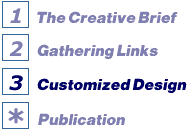 
Background & RationaleCustomized Design is the heart of Web-and-Flow Interactive. This is where you create one of six Activity Formats originally described in the article Working the Web for Education and updated for Web-and-Flow. Depending on the goals for learners, you might create something like a Topic Hotlist, Subject Sampler, WebQuest, or one of the new formats. What makes this process a learning experience, not a black box, is the first page of the Custom Design phase: Tom's Tips. This is where Web-and-Flow transplants Tom March's brain into Jodi Reed's perl script. Tom's been developing activities since the early days of the Web. Why shouldn't you benefit from his insights, trials, and errors? Customizing your learning design is a simple matter of filling in the interactive forms, sorting links, and refining your thinking into the text that becomes your Web-based activity. If you've used Filamentality, the process will be familiar, but we think you'll appreciate the advancements. After all you're paying $25 bucks a year for this, hey? Once you've gotten to this stage of the design process, you'll see that even though you have one learning goal in mind, you're already far along the path to creating other activities on this same topic. Let's say you want to create a WebQuest, but once you get to "Tom's Tips," you see it's no drama to also crank out a Subject Sampler to use as a motivating introduction to your unit. Cool to turn around and see good stuff coming your way, huh? The last piece that makes Web-and-Flow's Custom Design unique is the inclusion of an assessment rubric for each of the Activity Formats. Criteria and three levels are suggested (to save you time), but you can also re-write the descriptors any way you want (to make the assessment tool really reflect the activity you're designing). |